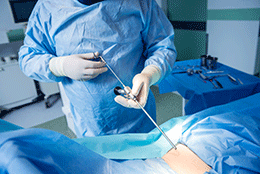 Leading manufacturers of non-invasive and minimally invasive medical devices depend on specialty Master Bond adhesive, sealant, and coating formulations, not only while designing, but also while assembling their devices. Custom formulated medical grade systems are available for multiple assembly applications. They consist of epoxy, silicone, cyanoacrylates, and UV curable compounds. These versatile compositions meet USP Class VI requirements for biocompatibility and/or ISO 10993-5 requirements for non-cytotoxicity. Most significantly many grades are designed to be resistant to repeated steam autoclave cycles, ethylene oxide (EtO), gamma radiation and chemical sterilants such as hydrogen peroxide, peracetic acid, Cidex®, and Sterrad®. Certain products have been developed to withstand multiple cycles of sterilization. Additionally, they protect against detergents, disinfectants, bleaches, antimicrobial cleaning agents, and isopropyl alcohol.
Leading manufacturers of non-invasive and minimally invasive medical devices depend on specialty Master Bond adhesive, sealant, and coating formulations, not only while designing, but also while assembling their devices. Custom formulated medical grade systems are available for multiple assembly applications. They consist of epoxy, silicone, cyanoacrylates, and UV curable compounds. These versatile compositions meet USP Class VI requirements for biocompatibility and/or ISO 10993-5 requirements for non-cytotoxicity. Most significantly many grades are designed to be resistant to repeated steam autoclave cycles, ethylene oxide (EtO), gamma radiation and chemical sterilants such as hydrogen peroxide, peracetic acid, Cidex®, and Sterrad®. Certain products have been developed to withstand multiple cycles of sterilization. Additionally, they protect against detergents, disinfectants, bleaches, antimicrobial cleaning agents, and isopropyl alcohol.
High quality liquid/paste systems have been produced to enhance device performance, safety, optimize processing, efficiency, precision, accuracy, durability and reliability. They offer engineers design flexibility, join similar/dissimilar substrates including stainless steel, titanium, aluminum, ABS, PMMA, nylon, PEEK, polycarbonate, polyethylene, polyurethane, nitinol, silicones, and glass. Different compositions maintain their structural integrity when exposed to tensile, shear, peel compressive and thermo-mechanical stresses. These systems cure at room temperature or when subjected to heat, UV light or moisture. Products can be formulated to bond and seal simultaneously, and/or fill gaps. Typically, they contain no solvents, are thermally stable and are easily dispensed automatically or manually.
Non-invasive medical devices do not enter the body. Master Bond medical grade adhesives can be formulated in the fabrication of the following types of non-invasive medical devices:
- Infrared thermometers
- Hearing aids
- Stethoscopes
- Blood pressure monitors
- Blood oxygen monitors
- External cardiac pacemakers
- Defibrillators
- ECGs
- CT scans
- Holter monitors
- MRIs
Master Bond adhesives can also be utilized in the construction of minimally invasive medical devices. Some notable examples are:
- Therapeutic catheters
- Bronchoscopes
- Endoscopes
- Hysteroscopes
- Laparoscopes
- Duodenoscopes
- Laryngoscopes
- Sigmoidoscopes
- Arthroscopes
- Thoracoscopes
- Neuroendoscopes
- Balloon inflation devices
- Tubular dilators
- Delivery and guide catheters
- Trocars
- Surgical scopes
- Cutting instruments
- Electrocautery instruments
The preference for minimally invasive medical procedures has grown considerably because:
- Smaller incisions
- Lower risk of infection
- Less scarring
- Shorter hospital stays
- Reduced trauma to the body
- Accelerated recovery time
- Higher accuracy rate
- Fewer incisions
Minimally invasive medical devices are commonly employed for:
- Abdominal surgery
- Gynecology
- Urology
- Pediatrics
- Cardiac surgery
- Neurosurgery
- Orthopedic surgery
- Thoracic surgery
- Cosmetic surgery
- Esophagus and lung surgery
- Esophagus
- Large intestine
- Pelvis and ureter
Recent technological advances and innovations have enabled manufacturers to build miniaturized devices for an assortment of procedures. This has had a major impact in achieving better patient outcomes. As minimally invasive surgical techniques continue to proliferate, Master Bond has taken the lead in rendering assistance in providing our unmatched technical expertise to create solutions to complex challenges. Our thermal management materials, conformal coatings, underfills, optical adhesives, stress absorbing systems, EMI/RFI shielding coatings and potting compounds can prove to be extremely valuable in these efforts. This encompasses the deployment of Master Bond products to boost the capability and potential use of cameras, mechanical, electronic components, fiber optics, sensors, eyepieces, lenses, light transmitting systems, controls, tubing, visual displays for these devices.
